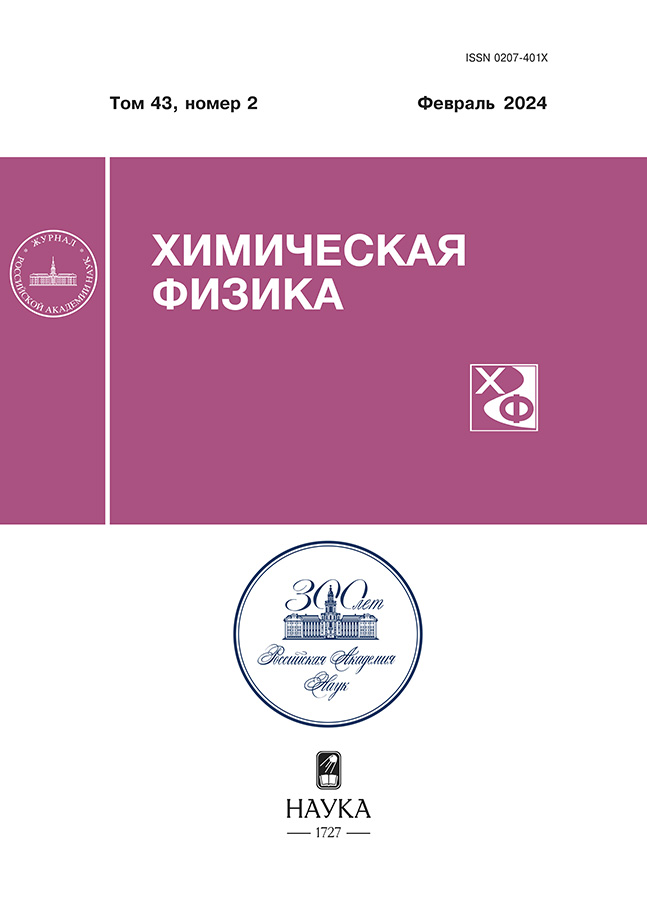Effect of terahertz radiation on the transport properties of albumin: binding with metal ions
- Autores: Nemova E.F.1, Kobzeva T.V.2, Dultseva G.G.2
-
Afiliações:
- Institute of Laser Physics, Siberian Branch of the Russian Academy of Sciences
- Voevodsky Institute of Chemical Kinetics and Combustion, Siberian Branch, Russian Academy of Sciences
- Edição: Volume 43, Nº 2 (2024)
- Páginas: 9-16
- Seção: ВЛИЯНИЕ ВНЕШНИХ ФАКТОРОВ НА ФИЗИКО-ХИМИЧЕСКИЕ ПРЕВРАЩЕНИЯ
- URL: https://cardiosomatics.orscience.ru/0207-401X/article/view/674982
- DOI: https://doi.org/10.31857/S0207401X24020022
- EDN: https://elibrary.ru/WIZMVW
- ID: 674982
Citar
Texto integral
Resumo
The effect of terahertz radiation on clusterization of bovine serum albumin (BSA) molecules and on BSA binding with nickel, cobalt and cadmium ions is investigated by means of high performance liquid chromatography and EPR spectroscopy under variation of the concentration of molecular oxygen in solution. Irradiation is detected to remove steric hindrance for oxygen adsorption. The degree of nickel and cobalt ion binding with irradiated BSA samples is substantially higher than with non-irradiated ones, while for cadmium the binding degree is the same and rather low in both cases. The functional groups in BSA molecule participating in metal ion binding are revealed by means of modeling.
Palavras-chave
Texto integral
Sobre autores
E. Nemova
Institute of Laser Physics, Siberian Branch of the Russian Academy of Sciences
Autor responsável pela correspondência
Email: endy.endy@gmail.com
Rússia, Novosibirsk
T. Kobzeva
Voevodsky Institute of Chemical Kinetics and Combustion, Siberian Branch, Russian Academy of Sciences
Email: endy.endy@gmail.com
Rússia, Novosibirsk
G. Dultseva
Voevodsky Institute of Chemical Kinetics and Combustion, Siberian Branch, Russian Academy of Sciences
Email: endy.endy@gmail.com
Rússia, Novosibirsk
Bibliografia
- Cherkasova O.P., Serdyukov D.S., Nemova E.F., Ratushnyak A.S., Kucheryavenko A.S., Dolganova I.N., Xu G., Skorobogatiy M., Reshetov I.V., Timashev P.S., Spektor I.E., Zaytsev K.I., Tuchin V.V. // J. Biomed. Optics, 2021. V. 26. P. 090902.
- Siegel P.H. // IEEE Trans. Microwave Theory Technol. 2004. V. 52. P. 2438−2447.
- Parrott E.P.J., Sun Y., Pickwell-MacPherson E. // J. Mol. Struct. 2011. 1006. P. 66−76.
- Cherkasova O.P., Fedorov V.I., Nemova E.F., Pogodin A.S. Optika I Spektroskopiya. 2009. V. 107. No. 4. P. 566. (In Russ.).
- Markelz A.G., Mittleman D.M. Photonics (ACS). https://doi.org/10.1021/acsphotonics.2c00228.
- Sitnikov D.S., Ilina I.V., Revkova V.A., Rodionov S.A., Gurova S.A., Shatalova R.O., Kovalev A.V., Ovchinnikov A.V., Chefonov O.V., Konoplyannikov M.A., Kalsin V.A., Baklaushev V.P. // Biomed. Opt. Express. 2021. No. 12. P. 7122.
- Yaekashiwa N, Yoshida H., Otsuki S, Hayashi S.I., Kawase K. // Photonics. 2019. No. 6. P. 33.
- Koyama S., Narita E., Suzuki Y., Shiina T., Taki M., Shinohara N., Miyakoshi J. // J. Radiat. Res. 2019. V. 60. P. 417.
- Shi W., Wang Y., Hou L., Ma C., Yang L., Dong C., Wang Z., Wang H., Guo J., Xu S., Li J. // J. Biophoton. 2021. V. 14. Article e202000237.
- Peng Y., Shi C., Wu X., Zhu Y., Zhuang S. // BME Frontiers. 2020. 2020. P. 1.
- Zaytsev K.I., Dolganova I.N., Chernomyrdin N.V., Katyba G.M., Gavdush A.A., Cherkasova O.P., Komandin G.A., Shchedrina M.A., Khodan A.N., Ponomarev D.S., Reshetov I.V., Karasik V.E., Skorobogatiy M., Kurlov V.N., Tuchin V.V. Journal of Optics. 2020. V. 22. No. 1. Article 013001. doi: 10.1088/2040-8986/ab4dc3.
- Son J.-H., Oh S.J., Cheon H.J. // Appl. Phys. 2019. V. 125. Article 190901.
- Wei L., Yu L., Jiaoqi H., Guorong H., Yang Z., Weiling F. // Frontiers in Laboratory Medicine. 2018. No. 2. P. 127.
- Di Fabrizio M., Lupi S., D’Arco A. // J. Phys.: Photonics. 2021. № 3. Article 032001.
- Schroer M.A., Schewa S., Gruzinov A. Y., Rönnau C., Lahey-Rudolph J.M., Blanchet C.E., Zickmantel T., Song Y.-H., Svergun D.I., Roessle M. // Sci. Rep. 2021. V. 11. P. 22311.
- Chen J.Y., Knab J.R., Ye S.J., He Y.F., Markelz A.G. // Appl. Phys. Lett. 2007. V. 90. 243901.
- Tan N.Y., Li R., Bräuer P., D’Agostino C., Gladden L.F., Zeitler J.A. // Phys. Chem. Chem. Phys. 2015. V. 17. P. 5999.
- Nemova E.F., Cherkasova O.P., Nikolaev N.A., Dultseva G.G. // Biophysics (Russian Federation). 2020. V. 65. No. 3. P. 410.
- Alhazmi H.A., Al Bratty M., Meraya A.M., Najmi A., Alam M.S., Javed S.A. // Acta Biochim. Pol. 2021. V. 68. No. 1. P. 99.
- Liu X.F., Xia Y.M., Fang Y. J. // Inorg Biochem. 2005. V. 99. No. 7. P. 1449. https://doi.org/10.1016/j.jinorgbio.2005.02.025. PMID: 15908003.
- Peng M., Shi S., Zhang Y. // Spectrochim Acta A Mol. Biomol. Spectrosc. 2012. V. 85. No. 1. P. 190. https://doi.org/10.1016/j.saa.2011.09.059.
- Hedberg Y.S., Dobryden I., Chaudhary H., Wei Z., Claesson P.M., Lendel C. // Colloids Surf B Biointerfaces. 2019. V. 173. P. 751.
- CRC Handbook of Chemistry and Physics. 95th edition. Ed. W.M. Haynes. CRC Press, 2014.
Arquivos suplementares













